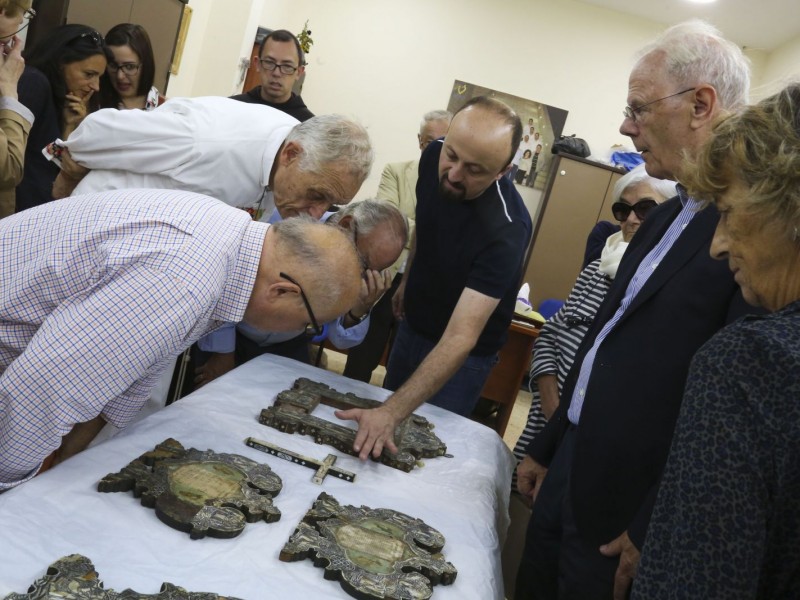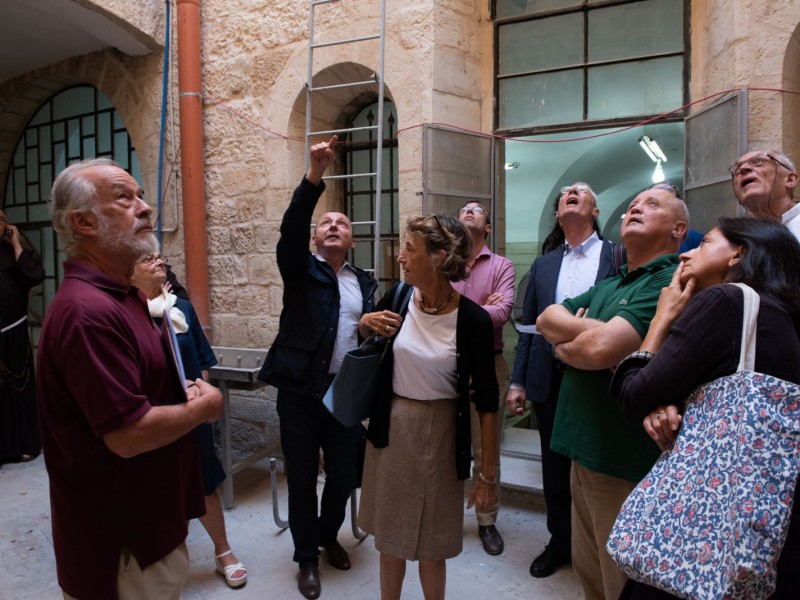Terra Sancta Museum, work begins at St. Savior’s Monastery
The Scientific Committee of the Terra Sancta Museum gathered at the St. Savior’s Monastery in Jerusalem, from Sunday, September 23, to Wednesday September 26, for the third meeting dedicated to the new section of the museum.
 The first day was dedicated to the discovery of the artistic heritage of Bethlehem. The experts were guided by the Piacenti company in a private visit of the restored mosaics located inside of the Basilica of the Nativity. “Before the restoration, we could not have possibly imagined that there were Byzantine mosaics. The subjects represented depict the Ecumenical Councils. This desire to remember the unity of the universal Church is even more important in this place where different Christian communities co-exist,” said Raphaëlle Ziade, the head of the Byzantine department at the Petit Palais in Paris. Then, George Lama, an art collector and consultant of the Committee—as well as a parishioner in Bethlehem—led the Committee inside of the laboratory belonging to Salim Atick, one of the last expert craftsmen of mother of pearl in Palestine, who has trained many students. This was also a helpful opportunity to see numerous pieces which, after their restoration, will be included in the future museum. “Dedicating a room in the museum to this craft is essential in my opinion, and it highlights the relationship between local Christians and the Custody, which has introduced and supported this profession so as to allow the Christian communities to develop economically,” said Lama. Many young researchers are interested in learning about this tradition, as is evidenced by the study by Francesca Biasio (University of Verona) on the mother of pearl collection guarded in the Holy Land by the Franciscan Minors. This study will likely will soon give rise to a catalog.
The first day was dedicated to the discovery of the artistic heritage of Bethlehem. The experts were guided by the Piacenti company in a private visit of the restored mosaics located inside of the Basilica of the Nativity. “Before the restoration, we could not have possibly imagined that there were Byzantine mosaics. The subjects represented depict the Ecumenical Councils. This desire to remember the unity of the universal Church is even more important in this place where different Christian communities co-exist,” said Raphaëlle Ziade, the head of the Byzantine department at the Petit Palais in Paris. Then, George Lama, an art collector and consultant of the Committee—as well as a parishioner in Bethlehem—led the Committee inside of the laboratory belonging to Salim Atick, one of the last expert craftsmen of mother of pearl in Palestine, who has trained many students. This was also a helpful opportunity to see numerous pieces which, after their restoration, will be included in the future museum. “Dedicating a room in the museum to this craft is essential in my opinion, and it highlights the relationship between local Christians and the Custody, which has introduced and supported this profession so as to allow the Christian communities to develop economically,” said Lama. Many young researchers are interested in learning about this tradition, as is evidenced by the study by Francesca Biasio (University of Verona) on the mother of pearl collection guarded in the Holy Land by the Franciscan Minors. This study will likely will soon give rise to a catalog.
Monday was dedicated to the progress of museography and to the architectural analyses of museum spaces. “We have arrived at the meeting between preliminary design and the actual project. Soon we will get into the details of every constructive element—from the windows to the lighting, to restoration of the works. This work has already been done and must now be compared with “real architectural feasibility,” said Thomas Gaehtgens of the Getty Research Institute in Los Angeles. There are two tracks that will be offered to the public: the shorter one that brings together the essential works and the longer one that included all 20 rooms of the museum. 
The following day, the conservation and preservation experts took the floor. The main topics of discussion were the order of the works, the depth of the windows and the lighting. The possibility of opening educational sites aimed at restoring some of the works selected for the exhibition was well received. What followed was discussion of the various thematic sections dedicated to the numerous research projects that are already underway: parameters, mother of pearl, icons and also the jewelery collection, of which a catalog will likely be published. A “volume zero” will bring together a selection of the main objects belonging to the Custody’s Archaeological and Historical Collection.The Committee members were also able to positively evaluate the precious work of cataloging and data collection carried out by interns from different university centers, such as universities of Bari and Verona and the Ecole du Louvre.
At the end of this session, the Committee visited the archaeological section that recently opened at the Monastery of the Flagellation. This was opportunity to admire the work that has been completed and to carry on with other museum sections.
The Scientific Committee finally declared that the last section of the Terra Sancta Museum should open on October 4, 2020, the feast day of St. Francis.



